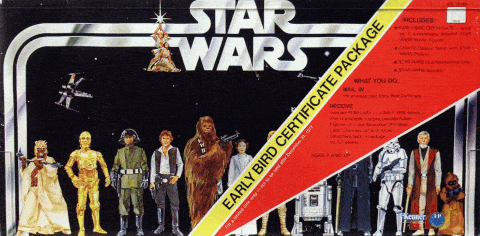This is a must read by Alexander Huls at popularmechanics.com
The mad world of Star Wars memorabilia collecting began with a plea for trust.
When George Lucas’s film premiered on May 25, 1977, no one knew it would even succeed, much less become a decades-spanning, money-making juggernaut. Certainly not Kenner, the company tasked with making Star Wars toys. Kenner had acquired the Star Wars merchandising license only a month before the film’s release. When kids immediately fell in love with Luke Skywalker, Princess Leia, and Darth Vader, their action figures were nowhere near ready.
So, for the 1977 Christmas season, Kenner came up with an unconventional idea: an IOU. The company’s $16 Early Bird Certificate Package was a box that included some stickers, a cardboard display stand for a dozen 3¾-inch action figures, and a mail-in offer to receive four of the upcoming figures (Luke Skywalker, Leia Organa, Chewbacca, and R2-D2) between February and June of 1978.
Kenner delivered on its promise. Throughout early 1978, children received the promised four figures, kindling interest in completing the full 12-piece set. These first dozen toys, known as 12-backs, went on to sell 26 million units that year, kick-starting what would become one of the biggest toy franchises in history. To date, Star Warsmerch has moved nearly $20 billion in sales.
That first act of trust ignited a phenomenon. Star Wars collecting became a hobby, then a passion, then a worldwide industry with insurance policies protecting collections worth millions and collectors chasing the rarest and most elusive pieces. In 2017, that hobby would be tested by an aspiring collector, a thief hidden in plain sight, and a rare plastic action figure worth more than your average car.
In early February 2017, 39-year-old collector Zach Tann would unknowingly set in motion one of the biggest scandals in Star Wars collecting history.
Sit back and click here to read it all at popularmechanics.com

